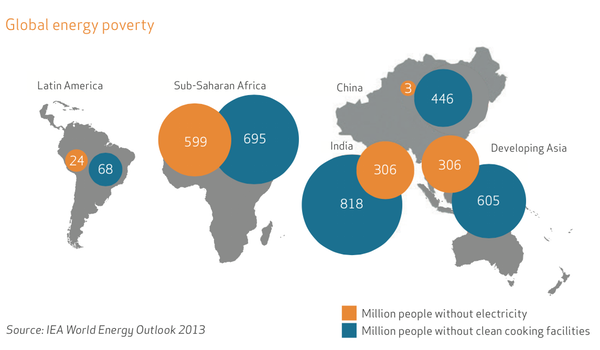What Would The World Look Like Without Fossil Fuels?
The United States is fortunate to enjoy abundant natural resources,
including a diverse energy portfolio. While much attention is paid to
climate change, we tend to ignore the tremendous benefits that we enjoy
because of that abundant energy mix, including coal, natural gas, oil,
nuclear and renewables. In particular, the backbone of our electricity
generation depends on fossil fuels. Sixty-seven percent of U.S. power
generation depends on them [1] because they meet the tremendous demands
of our country for affordable, reliable energy. Globally, fossil
fuels provide 87 percent of the world’s energy needs [2].Fossil fuels are in demand because they are dependable. As World Bank President Jim Young Kim has commented, “There’s never been a country that has developed with intermittent power [3].” Intermittent power is power that is not continuously available due to factors, as in the case of renewables, when the sun is not shining or the wind is not blowing. In comparison, baseload power sources are those plants that can generate dependable power to consistently meet demand over a 24-hour period. Only coal, nuclear, gas and large-scale hydro can provide baseload power.
In a world where over 2.6 billion people lack reliable electricity, proper medical care and adequate nutrition, fossil fuels have played a central role in addressing the urgent needs of those who are suffering. Fossil fuels have lifted over 660 million people in China out of poverty. Yet even today, over one billion people still lack adequate health care; and 400 million people in India alone remain without electricity [4]. Affluent nations need to strongly consider the U.N.’s first millennium goal: To eradicate extreme poverty and hunger. This moral imperative cannot be accomplished without the life-saving benefit of fossil fuels.

(Click on the image to view a larger version.)
 Our Food Supply Depends On Them:
Our Food Supply Depends On Them:Farms growing the crops and raising the livestock that feed our nation depend on fossil fuels to irrigate their fields, heat their barns, thresh their wheat and gather their corn. The trains that transport those goods to market and the refrigerators we use to preserve and keep them safe all rely on fossil fuels.
 Our Health And Medical Care Depends On Them:
Our Health And Medical Care Depends On Them:Hospitals, medical care and laboratories all depend on fossil fuels to generate the electricity that powers dialysis machines, respirators, X-Ray, MRI and EKG machines, to name a few. Just about any aspect of medical care depends on the power from fossil fuels.
 Our Advanced Standard Of Living Depends On Them:
Our Advanced Standard Of Living Depends On Them:Our high-tech devices, including computers, tablets, smart phones, high definition TVs and iPods, all depend on fossil fuels. In fact, the world’s Information-Communications Technologies (ICT) ecosystem uses as much electricity annually as the electric generation of Japan and Germany combined [1].
 Homes:
Homes:Our homes, with heat and air conditioning to keep us comfortable and protected in all types of weather conditions, are powered by fossil fuels.

Technology:
New technology advancements, from electric cars to wind turbines, all depend on power from fossil fuels.
Globally, increased fossil fuels use, and particularly coal, which is affordable and readily available, has led to improved quality of life because as electricity consumption increases, infant mortality rate decreases and access to improved drinking water sources increases [6].
What About Fossil Fuels’ Impact On The Environment?

Fossil fuels do emit by-products, examples being particulates such as sulphur dioxide (SO2), nitrous oxide (NO2) and particulates (PM).
In the U.S., however, while we have seen an increase in fossil fuel use since 1970, U.S. air pollution has gone down [7]. This is due to the development of advanced emission control technologies. For example, a new coal power plant employing advanced technologies emits 90 percent fewer emissions than the older coal plant it replaces [8].
Globally, fossil fuel-based energy has resulted in:
- Tremendous increases in safe water, through pipelines, water treatment centers and disinfectant processes;
- Eradication of deadly diseases through manufacture of vaccinations, construction of medical centers for preventative tests and application of advanced technologies around treatment and prevention;
- Modern sanitation systems that have wiped out major diseases, such as cholera.
What About Carbon Emissions?
As climate scientists have increasingly focused on CO2 emissions and
their impact on climate, industry has steadily been making progress in
developing new methods for minimizing those emissions.In the case of coal, the newer Supercritical Pulverized Coal plants are on average 20 percent more efficient and in the best cases as much as 32 percent lower in emissions than the older plants scheduled to retire – representing a significant improvement. Some of the newest Ultra-Super critical Pulverized Coal plants are close to 40 percent more efficient, and render sizable reductions in carbon emissions.
In the case of Carbon Capture and Sequestration (CCS) technologies, which seek to develop methods of collecting most of the carbon emissions and storing them, or repurposing them, those technologies are still in the developmental or trial phases. However, several projects in progress in the United States that hold promise include:
- Kemper project in Mississippi, a subsidiary of Southern Company, the plant will capture about 3- million metric tons of CO2 per year—65 percent of the total—to be used for enhanced oil recovery (EOR) in oilfields;
- FutureGen 2.0, a public-private partnership project aimed at achieving near zero carbon emissions(DOE recently announced that it is suspending funding for this project);
- Summit’s Texas Clean Energy Project in Penwell, Texas;
- Petra Nova Carbon Capture Project in Thompsons, Texas that is designed to capture 90 percent of carbon emissions, among several other CCS projects.
[1] Source: US Energy Information Administration
[2] Source: BP’s Latest Statistical Review (2014)
[3] Source: World Bank
[4] Source: World Energy Outlook
[5] Source: Link
[6] (World Bank, World Development Indicators (WDI) Online Data, April 2014)
[7] Source: U.S. EPA National Emissions inventory Air Pollutant Emissions Trends Data
[8] Source: National Energy Technology Laboratory


No comments:
Post a Comment